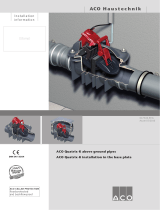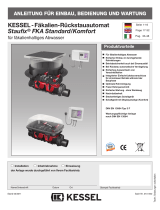
ACO Haustechnik
Quatrix-K Fäkalien-Rückstauautomat
Diese Übersicht enthält nur auszugsweise Informationen. Für eine sichere und sachgerechte Montage und
Anwendung, Einbau- und Gebrauchsanleitung aufmerksam lesen.
Einsatzbedingungen für Rückstauverschlüsse
ACHTUNG Der Schutz gegen Rückstau erfolgt durch Abwasserhebeanlagen mit Rückstauschleife. Rückstau-
verschlüsse sind für den häuslichen Gebrauch bestimmt, und nur zulässig, wenn die örtlichen Bauvorschriften und
folgende Voraussetzungen gemäß DIN EN 12056-4 eingehalten sind:
■
Gefälle der Entwässerungsleitung zur Kanalisation.
■
Keine Beeinträchtigung der Gesundheit von Personen bei Überflutung oder Gefährdung hoher Sachwerte.
■
Der Benutzerkreis ist klein und diesem steht ein WC oberhalb der Rückstauebene zur Verfügung.
■
Auf die angeschlossenen Ablaufstellen kann bei einem Rückstau verzichtet werden.
ACHTUNG Unsachgemäßer Einbau:
Selbstüberflutung bei unsachgemäßem Einbau und
Rückstau, wenn Ablaufstellen über der Rückstauebene zu
einem Rückstauverschluss geführt werden.
Ordnungsgemäßer Einbau: Nur Ablaufstellen unter
der Rückstauebene zu einem Rückstauverschluss führen.
Fallleitungen für Regenwasser in Fließ richtung hinter dem
Rückstau verschluss anschließen.
Netzbetrieb
1x: Ton ausTest Betriebsverschluss
1x: Zufahrt
2x: Auffahrt
2x: Grundeinstellung
nach Störung
Dauerleuchten
Ausschalten
1. Netzstecker ziehen
2. Tasten (links/rechts)
gleichzeitig
5 Sekunden lang
drücken.
Einschalten
3. Netzstecker ein-
stecken um
Initialisierung
zu starten.
Blinkleuchten
Akkubetrieb
Rückstau
Betriebsverschluss zu
Motorstörung
Akkustörung
Betriebsverschluss fährt auf/zu
Netzbetrieb
1x: Ton ausTest Betriebsverschluss
1x: Zufahrt
2x: Auffahrt
2x: Grundeinstellung
nach Störung
Dauerleuchten
Ausschalten
1. Netzstecker ziehen
2. Tasten (links/rechts)
gleichzeitig
5 Sekunden lang
drücken.
Einschalten
3. Netzstecker ein-
stecken um
Initialisierung
zu starten.
Blinkleuchten
Akkubetrieb
Rückstau
Betriebsverschluss zu
Motorstörung
Akkustörung
Betriebsverschluss fährt auf/zu
Gehäusedeckel montieren
ACHTUNG Beim Aufsetzen des Gehäuse deckels auf die
Stellung von Spindel und Notverschluss achten.
Î
Knebelmutter auf die Spindel setzen und soweit
drehen (1), bis die Spindel ca. 20 mm aus dem
Mitnehmer herausragt (2).
Î
Roten Hebel (Notverschluss) senkrecht stellen (3).
Î
Gehäusedeckel auf das Gehäuse setzen und
Hutmuttern über Kreuz mit 5 bis 8 Nm anziehen.
Î
Roten Hebel (Notverschluss) entgegen der
Fließrichtung bis zum Anschlag drücken, um den
Notverschluss zu öffnen.
3.
90°
1.
2.
20
mm
Rückstauebene Rückstauebene
Voraussetzungen für die Inbetriebnahme
■
Dichtigkeitsprüfung und Funktionsprüfung Notverschluss sind erfolgt, Gebrauchsanleitung.
■
Druckschlauch ist ohne Schlaufen oder Knicke mit einem Gefälle (> 1%) zum Rückstauverschluss verlegt.
■
Steuergerät ist vor Überflutung und Frost geschützt (> 5 °C) sowie gut sichtbar und bedienbar montiert.
■
Elektromotor ist montiert (Motoraufnahme vorher gesäubert und eingefettet) und angeschlossen
Steuergerät einschalten
Î
Netzstecker in eine abgesicherte Steckdose stecken. Das Steuergerät führt einen Selbsttest durch.
Ablauf Selbsttest:
■
Grüne LED (1) leuchtet: Steuergerät ist betriebsbereit (Stromversorgung
hergestellt).
■
Rote LED (4) blinkt (ca. 15 Sekunden): Ladezustand des Akkus (im
Steuergerät) wird geprüft.
Ist der Ladezustand zu gering, wird der Akku geladen
(max. 10 Minuten).
Rote LED (4) blinkt und der Alarm ertönt: Akku tiefentladen, defekt
oder Sicherung defekt, Gebrauchsanleitung.
■
Gelbe LED (3) blinkt: Betriebsverschluss (Rückstauklappe) wird geprüft. Dabei wird der Betriebsverschluss
(Rückstauklappe) geschlossen und wieder geöffnet.
■
Nur grüne LED (1) leuchtet: Rückstauautomat ist betriebsbereit.
■
Ist dies nicht der Fall oder der Alarm ertönt, Gebrauchsanleitung.
Betriebsverschluss (Rückstauklappe) schließen und öffnen:
Î
Schließen: Taste (6) drücken. Der Alarm ertönt (nur bei Rückstau oder Störung mit der Taste (5) ausschaltbar).
Î
Öffnen: Taste (6) erneut drücken.
Rückstauerkennung prüfen
Î
Druckschlauch vom Druckschlauch-Anschluss
(Gehäusedeckel) entfernen (1).
Î
Druckschlauch ca. 150 mm in einen mit Wasser
gefüllten Behälter (z. B. Flasche) einführen (2).
Ordnungsgemäße Rückstauerkennung:
■
Rote LED (2) leuchtet.
■
Gelbe LED (3) blinkt, während der Betriebsverschluss
schließt.
■
Gelbe LED (3) leuchtet und der Alarm ertönt: der
Betriebsverschluss ist geschlossen.
Î
Taste (5) drücken, um den Alarmton auszuschalten.
2.
150
mm
1.
Î
Druckschlauch aus dem Behälter nehmen. Betriebsverschluss öffnet automatisch nach ca. 30 Sekunden.
Î
Druckschlauch wieder auf den Druckschlauch-Anschluss stecken und mit der Überwurfmutter fest schrauben.
Steuergerät ausschalten
Î
Netzstecker ziehen.
Î
Taste (5) und Taste (6) ca. 3 Sekunden gleichzeitig drücken.
Zur Bestätigung leuchten alle LEDs einmal auf.
0850.01.02 V 1.0Ausgabe: 2014–06–05

Netzbetrieb
1x: Ton ausTest Betriebsverschluss
1x: Zufahrt
2x: Auffahrt
2x: Grundeinstellung
nach Störung
Dauerleuchten
Ausschalten
1. Netzstecker ziehen
2. Tasten (links/rechts)
gleichzeitig
5 Sekunden lang
drücken.
Einschalten
3. Netzstecker ein-
stecken um
Initialisierung
zu starten.
Blinkleuchten
Akkubetrieb
Rückstau
Betriebsverschluss zu
Motorstörung
Akkustörung
Betriebsverschluss fährt auf/zu
Quatrix-K Automatic Faecal Backflow Stop
This document is intended as a quick installation guide. To ensure the equipment is fitted and used safely and
correctly, read the full installation and operating instructions supplied with the unit carefully.
Conditions of Use for Backflow Stops
CAUTION Protection against backflow is provided by wastewater lifting plants with a backflow loop. Backflow stops
are designed for domestic use and may only be used if permitted by local building regulations and the following
requirements according to EN 12056-4 are adhered to:
■
Positive Gradient from the drainage line into the sewerage system.
■
No threat to human health in the event of flooding or threat to high-value items.
■
There are only a small number of users and they have a WC available above the backflow level that is not
connected to the backflow stop.
■
Sanitary appliances do not need to be used during flooding
CAUTION Incorrect installation: Drainage points
ABOVE the backflow level must NOT be connected
upstream of the Quatrix unit as WC’s, baths and showers
cannot be used during a backflow situation.
Correct installation: Drainage points above the
backflow level MUST be connected downstream of
Quatrix unit. Sanitary units above the backflow level can
be used in g a backflow situation.
Netzbetrieb
1x: Ton ausTest Betriebsverschluss
1x: Zufahrt
2x: Auffahrt
2x: Grundeinstellung
nach Störung
Dauerleuchten
Ausschalten
1. Netzstecker ziehen
2. Tasten (links/rechts)
gleichzeitig
5 Sekunden lang
drücken.
Einschalten
3. Netzstecker ein-
stecken um
Initialisierung
zu starten.
Blinkleuchten
Akkubetrieb
Rückstau
Betriebsverschluss zu
Motorstörung
Akkustörung
Betriebsverschluss fährt auf/zu
Mounting the Housing Cover
CAUTION When positioning the housing cover,
pay attention to the positions of the spindle and the
emergency lock.
Î
Place the red manual drive nut (1) on the spindle and
turn it until the spindle is protruding approximately
20 mm from the threaded actuator (2).
Î
Move the red lever (emergency lock) to a vertical
position (3).
Î
Place the housing cover on the housing and tighten
the cap nuts to between 5 and 8 Nm, alternating
between nuts on opposite sides.
Î
Push the red lever (emergency lock) as far as it will go
against the ow direction to open the emergency lock.
3.
90°
1.
2.
20
mm
Backflow level Backflow level
ACO Building Drainage
Prerequisites for Commissioning
■
Water tightness and function test of emergency lock have been performed; operating instructions.
■
Pressure hose is installed with a gradient (> 1%) and without any loops or kinks. This is very important otherwise the
pressure sensor will be unable to detect a backflow.
■
The control device is protected against flooding and frost (> 5°C), and is mounted in a way that makes it clearly visible
and easy to operate.
■
motor is mounted (spindle has been cleaned and greased before) and installed
Switching On the Control Device
Î
Connect the mains plug to a mains socket with fuse protection. The control device will perform a self-test.
Self-test process:
■
Green LED (1) lights up: control device is ready for operation (power supply
is established).
■
Red LED (4) flashes (approx. 15 seconds): charge state of the battery (in
the control device) is being checked.
If the charge state is too low, the battery is charged (max. 10 minutes).
Red LED (4) flashes and alarm sounds: battery is deep-discharged or
defective, or the fuse is defective; operating instructions.
■
Yellow LED (3) flashes: operating seal (backflow flap) is being checked. To
do this, the operating seal (backflow flap) is closed and reopened.
■
Only green LED (1) lights up: automatic backflow stop is ready for operation.
■
If this is not the case or if the alarm sounds, operating instructions.
Closing and opening the operating seal (backflow flap) mannually:
Î
To close: press key (6). The alarm sounds (can only be deactivated with key (5) in the event of a backflow or
malfunction).
Î
To open: press key (6) again.
Checking Backflow Detection
Î
Remove the pressure hose from the pressure hose
connection (housing cover; 1).
Î
Insert the pressure hose approx. 150 mm into a
container filled with water, such as a bottle (2).
Correct backflow detection:
■
Red LED (2) lights up.
■
Yellow LED (3) flashes while the operating seal closes.
■
Green LED (3) lights up and alarm sounds: the
operating seal is closed.
Î
Press key (5) to deactivate the alarm signal.
Î
Remove the pressure hose from the container. The
operating seal opens automatically after approx. 30
seconds.
2.
150
mm
1.
Î
Attach the pressure hose to the Quatrix unit connection again and tighten it using the union nut.
Switching Off the Control Device
Î
Remove out the mains plug.
Î
Press keys (5) and (6) simultaneously for approx. 3 seconds.
All the LEDs will light up once as confirmation.
0850.01.02 V 1.0Issued: 2014–06–05
-
 1
1
-
 2
2
Ask a question and I''ll find the answer in the document
Finding information in a document is now easier with AI
in other languages
- Deutsch: ACO Quatrix-K Schnellstartanleitung
Other documents
-
 ACO Haustechnik ACO Quatrix-K Series Installation Information
ACO Haustechnik ACO Quatrix-K Series Installation Information
-
 Kessel Staufix FKA Standard Installation guide
Kessel Staufix FKA Standard Installation guide
-
Grundfos rmq-a Installation & Operating Instruction
-
Marantec CS 310 Owner's manual
-
Marantec CS 310 Owner's manual
-
Marantec CS 310 FU Owner's manual
-
Marantec CS 310 FU Owner's manual
-
Marantec CS 310 Owner's manual
-
AEG RTi 103 EP Owner's manual
-
Marantec CS 310 FU Owner's manual



